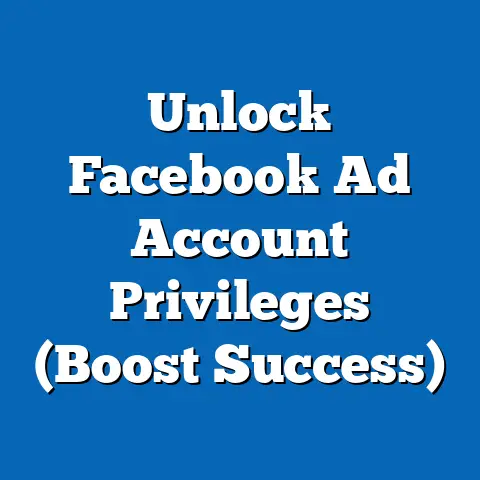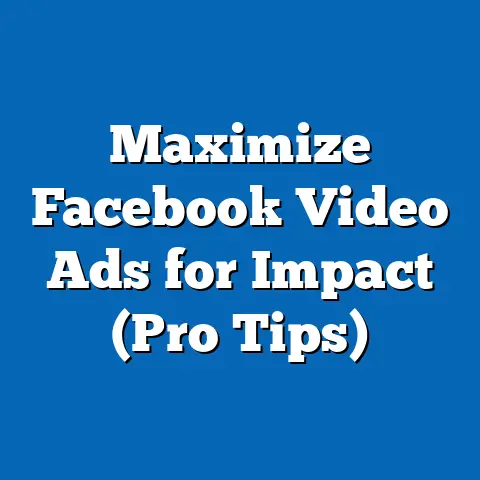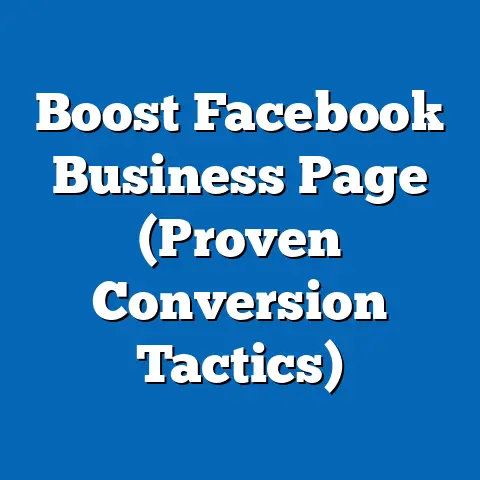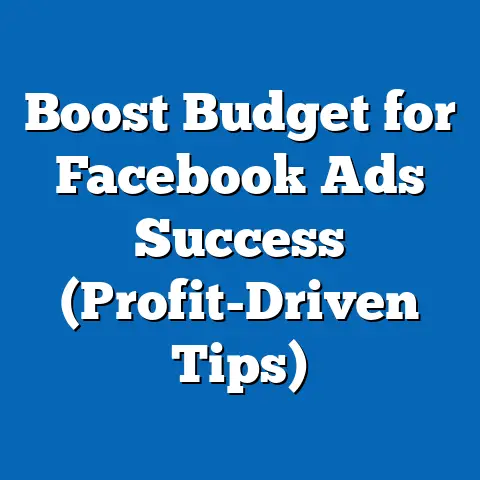Engage New Movers with Facebook Ads (Smart Strategies)
I’ve always been fascinated by how people adapt and change their lives when they move to a new place. It reminds me of the Great Migration in the early 20th century, when millions of African Americans journeyed from the rural South to the bustling cities of the North. They were seeking better opportunities, a fresh start, and a new community. This massive demographic shift not only reshaped cities but also created vibrant new markets.
Today, we see a similar phenomenon, albeit on a more individual and continuous scale. People are constantly relocating – for jobs, family, lifestyle changes, or simply a desire for something new. This constant churn presents a unique opportunity for businesses. Think about it: new movers are essentially blank slates, ready to discover new services, products, and establish new loyalties. That’s why reaching out to them effectively is so crucial.
Facebook, with its vast reach and sophisticated targeting capabilities, is an incredibly powerful tool for connecting with this audience. In this guide, I’ll share smart strategies to leverage Facebook Ads to engage new movers and turn them into loyal customers.
Understanding the New Movers Market
Before diving into the tactics, it’s essential to understand who we’re targeting. So, who exactly are “new movers”?
-
Definition: New movers are individuals or families who have recently relocated to a new geographic area. This could be within the same city, across state lines, or even internationally.
-
Statistics: According to the U.S. Census Bureau, millions of Americans move each year. While the moving rate has fluctuated over time, it remains a significant trend. In 2022, around 27 million people moved in the United States. This constant movement creates a dynamic market ripe with opportunities.
-
Psychological and Behavioral Characteristics: Moving is a significant life event, often accompanied by stress, uncertainty, and a strong desire to establish a new routine. New movers are actively searching for information about their new surroundings. They need to find:
- Local services (doctors, dentists, mechanics)
- Restaurants and shops
- Schools and childcare
- Community events and activities
- Home services (internet, utilities, cleaning)
This makes them highly receptive to targeted advertising that addresses these needs. They’re actively looking for solutions, and if your business can provide them, you’re in a prime position to gain a new customer.
-
Facebook’s Potential: Facebook’s extensive reach and granular targeting make it an ideal platform for reaching new movers. With billions of active users worldwide, it’s likely that a significant portion of your target audience is on the platform. Moreover, Facebook’s data allows you to pinpoint individuals who have recently updated their location or expressed interest in moving-related topics.
Definition: New movers are individuals or families who have recently relocated to a new geographic area. This could be within the same city, across state lines, or even internationally.
Statistics: According to the U.S. Census Bureau, millions of Americans move each year. While the moving rate has fluctuated over time, it remains a significant trend. In 2022, around 27 million people moved in the United States. This constant movement creates a dynamic market ripe with opportunities.
Psychological and Behavioral Characteristics: Moving is a significant life event, often accompanied by stress, uncertainty, and a strong desire to establish a new routine. New movers are actively searching for information about their new surroundings. They need to find:
- Local services (doctors, dentists, mechanics)
- Restaurants and shops
- Schools and childcare
- Community events and activities
- Home services (internet, utilities, cleaning)
This makes them highly receptive to targeted advertising that addresses these needs. They’re actively looking for solutions, and if your business can provide them, you’re in a prime position to gain a new customer.
Facebook’s Potential: Facebook’s extensive reach and granular targeting make it an ideal platform for reaching new movers. With billions of active users worldwide, it’s likely that a significant portion of your target audience is on the platform. Moreover, Facebook’s data allows you to pinpoint individuals who have recently updated their location or expressed interest in moving-related topics.
Takeaway: New movers represent a valuable and receptive market. Understanding their needs and leveraging Facebook’s targeting capabilities are key to successful engagement.
The Importance of Timing in Your Ads
Timing is everything when it comes to reaching new movers. You need to catch them at the right moment, when they’re most open to new information and making purchasing decisions.
-
The Critical Window: The first few weeks and months after a move are crucial. During this period, new movers are actively seeking information and making decisions about their new home and community. A study by Epsilon found that new movers are five times more likely to become long-term customers if contacted within the first 90 days of their move.
-
Location-Based Targeting: Facebook’s location-based targeting allows you to reach individuals who have recently changed their address. You can target users within a specific radius of a zip code or city, ensuring that your ads are seen by those who have just moved into the area. I’ve found that setting a radius of 5-10 miles around a specific neighborhood works well for local businesses.
-
Analyzing Moving Seasons: Moving activity tends to peak during certain times of the year. Summer is typically the busiest season, as families often prefer to move when school is out. However, other factors, such as job market trends and local economic conditions, can also influence moving patterns. Analyzing these trends can help you optimize your campaign timing and budget allocation. For example, if you’re a landscaping company, you might ramp up your ad spend in the spring as people start focusing on their yards.
Pro Tip: Use Google Trends to research local moving trends and identify peak seasons in your target area.
The Critical Window: The first few weeks and months after a move are crucial. During this period, new movers are actively seeking information and making decisions about their new home and community. A study by Epsilon found that new movers are five times more likely to become long-term customers if contacted within the first 90 days of their move.
Location-Based Targeting: Facebook’s location-based targeting allows you to reach individuals who have recently changed their address. You can target users within a specific radius of a zip code or city, ensuring that your ads are seen by those who have just moved into the area. I’ve found that setting a radius of 5-10 miles around a specific neighborhood works well for local businesses.
Analyzing Moving Seasons: Moving activity tends to peak during certain times of the year. Summer is typically the busiest season, as families often prefer to move when school is out. However, other factors, such as job market trends and local economic conditions, can also influence moving patterns. Analyzing these trends can help you optimize your campaign timing and budget allocation. For example, if you’re a landscaping company, you might ramp up your ad spend in the spring as people start focusing on their yards.
Pro Tip: Use Google Trends to research local moving trends and identify peak seasons in your target area.
Takeaway: Timing is critical. Target new movers within the first 90 days of their move, leverage location-based targeting, and align your campaigns with peak moving seasons.
Crafting Compelling Ad Content
Once you’ve identified your target audience and optimized your timing, the next step is to create ad content that resonates with new movers.
-
Content That Resonates: New movers are primarily interested in information that helps them settle into their new surroundings. This includes:
- Local Services: Ads for plumbers, electricians, cleaning services, and other home maintenance providers are highly relevant.
- Community Events: Promoting local festivals, farmers’ markets, and other community gatherings can help new movers feel more connected.
- Neighborhood Guides: Creating informative guides about the best restaurants, parks, and attractions in the area can be a valuable resource.
- Welcome Offers: Offer special discounts or promotions specifically for new movers to incentivize them to try your business.
-
Effective Ad Copy: Your ad copy should speak directly to the needs and challenges of new movers. Use language that is welcoming, informative, and reassuring. Here are some examples:
- Home Services: “Just moved in? Get $25 off your first cleaning service with [Your Business Name]! We’re your local experts for a spotless home.”
- Local Restaurants: “Welcome to the neighborhood! Enjoy a free appetizer at [Your Restaurant Name] when you mention this ad. We’re serving up delicious [cuisine] right around the corner.”
- Schools: “Looking for the best schools in [Neighborhood]? [Your School Name] offers a nurturing environment and a proven track record of academic success. Schedule a tour today!”
-
Testimonials and Community Highlights: Building trust is crucial. Include testimonials from satisfied customers who have recently moved to the area. Highlight your business’s involvement in the community and showcase your commitment to serving local residents. I’ve seen great results using video testimonials in Facebook ads. Seeing a real person talk about their positive experience can be incredibly persuasive.
Content That Resonates: New movers are primarily interested in information that helps them settle into their new surroundings. This includes:
- Local Services: Ads for plumbers, electricians, cleaning services, and other home maintenance providers are highly relevant.
- Community Events: Promoting local festivals, farmers’ markets, and other community gatherings can help new movers feel more connected.
- Neighborhood Guides: Creating informative guides about the best restaurants, parks, and attractions in the area can be a valuable resource.
- Welcome Offers: Offer special discounts or promotions specifically for new movers to incentivize them to try your business.
Effective Ad Copy: Your ad copy should speak directly to the needs and challenges of new movers. Use language that is welcoming, informative, and reassuring. Here are some examples:
- Home Services: “Just moved in? Get $25 off your first cleaning service with [Your Business Name]! We’re your local experts for a spotless home.”
- Local Restaurants: “Welcome to the neighborhood! Enjoy a free appetizer at [Your Restaurant Name] when you mention this ad. We’re serving up delicious [cuisine] right around the corner.”
- Schools: “Looking for the best schools in [Neighborhood]? [Your School Name] offers a nurturing environment and a proven track record of academic success. Schedule a tour today!”
Testimonials and Community Highlights: Building trust is crucial. Include testimonials from satisfied customers who have recently moved to the area. Highlight your business’s involvement in the community and showcase your commitment to serving local residents. I’ve seen great results using video testimonials in Facebook ads. Seeing a real person talk about their positive experience can be incredibly persuasive.
Takeaway: Craft ad content that addresses the immediate needs of new movers, uses welcoming language, and builds trust through testimonials and community highlights.
Utilizing Facebook’s Targeting Features
Facebook offers a range of advanced targeting options that can help you reach new movers with precision.
-
Custom Audiences: Custom Audiences allow you to upload your own customer data (e.g., email lists, phone numbers) to Facebook. You can then target these individuals with your ads. This is particularly useful if you have a list of new residents who have signed up for a welcome package or requested information about your services.
-
Lookalike Audiences: Lookalike Audiences are one of my favorite Facebook Ads features. They allow you to create a new audience that is similar to your existing customer base. Facebook analyzes the demographics, interests, and behaviors of your current customers and identifies other users who share those characteristics. This is an excellent way to expand your reach and find new movers who are likely to be interested in your business.
-
Demographic Filters: Facebook allows you to filter your audience based on demographics such as age, gender, education, and income. This can be helpful for targeting specific segments within the new movers category. For example, if you’re a real estate agent specializing in luxury homes, you might want to target high-income individuals who have recently moved to the area.
-
Step-by-Step Guide to Setting Up a Campaign:
- Create a new campaign in Facebook Ads Manager.
- Choose an objective: Consider objectives like “Brand Awareness,” “Reach,” or “Lead Generation.”
- Define your audience: Use location-based targeting to reach new movers in your target area.
- Create a Custom Audience or Lookalike Audience if you have relevant data.
- Set your budget and schedule: Determine how much you’re willing to spend and how long you want your campaign to run.
- Design your ads: Craft compelling ad copy and visuals that resonate with new movers.
- Track your results: Monitor your campaign performance and make adjustments as needed.
Custom Audiences: Custom Audiences allow you to upload your own customer data (e.g., email lists, phone numbers) to Facebook. You can then target these individuals with your ads. This is particularly useful if you have a list of new residents who have signed up for a welcome package or requested information about your services.
Lookalike Audiences: Lookalike Audiences are one of my favorite Facebook Ads features. They allow you to create a new audience that is similar to your existing customer base. Facebook analyzes the demographics, interests, and behaviors of your current customers and identifies other users who share those characteristics. This is an excellent way to expand your reach and find new movers who are likely to be interested in your business.
Demographic Filters: Facebook allows you to filter your audience based on demographics such as age, gender, education, and income. This can be helpful for targeting specific segments within the new movers category. For example, if you’re a real estate agent specializing in luxury homes, you might want to target high-income individuals who have recently moved to the area.
Step-by-Step Guide to Setting Up a Campaign:
- Create a new campaign in Facebook Ads Manager.
- Choose an objective: Consider objectives like “Brand Awareness,” “Reach,” or “Lead Generation.”
- Define your audience: Use location-based targeting to reach new movers in your target area.
- Create a Custom Audience or Lookalike Audience if you have relevant data.
- Set your budget and schedule: Determine how much you’re willing to spend and how long you want your campaign to run.
- Design your ads: Craft compelling ad copy and visuals that resonate with new movers.
- Track your results: Monitor your campaign performance and make adjustments as needed.
Takeaway: Leverage Facebook’s Custom Audiences, Lookalike Audiences, and demographic filters to target new movers with precision. Follow the step-by-step guide to set up a targeted ad campaign.
Measuring Success and Optimizing Campaigns
No Facebook ad campaign is complete without careful monitoring and optimization. You need to track your results and make adjustments to improve your performance.
-
Key Performance Indicators (KPIs): Focus on metrics that are relevant to your campaign objectives. Some important KPIs for engaging new movers include:
- Reach: The number of unique users who saw your ad.
- Impressions: The number of times your ad was displayed.
- Click-Through Rate (CTR): The percentage of users who clicked on your ad.
- Conversion Rate: The percentage of users who took a desired action (e.g., signing up for a newsletter, making a purchase).
- Cost Per Acquisition (CPA): The cost of acquiring a new customer through your ad campaign.
-
A/B Testing: A/B testing involves creating multiple versions of your ad and testing them against each other to see which performs best. You can test different ad copy, visuals, and targeting options. For example, you might test two different headlines to see which one generates a higher click-through rate.
-
Case Studies: Look for examples of brands that have successfully engaged new movers through targeted Facebook advertising. Analyze their strategies and identify what made them effective. For example, a local moving company might highlight its partnership with a real estate agency to offer a seamless moving experience for new residents.
Key Performance Indicators (KPIs): Focus on metrics that are relevant to your campaign objectives. Some important KPIs for engaging new movers include:
- Reach: The number of unique users who saw your ad.
- Impressions: The number of times your ad was displayed.
- Click-Through Rate (CTR): The percentage of users who clicked on your ad.
- Conversion Rate: The percentage of users who took a desired action (e.g., signing up for a newsletter, making a purchase).
- Cost Per Acquisition (CPA): The cost of acquiring a new customer through your ad campaign.
A/B Testing: A/B testing involves creating multiple versions of your ad and testing them against each other to see which performs best. You can test different ad copy, visuals, and targeting options. For example, you might test two different headlines to see which one generates a higher click-through rate.
Case Studies: Look for examples of brands that have successfully engaged new movers through targeted Facebook advertising. Analyze their strategies and identify what made them effective. For example, a local moving company might highlight its partnership with a real estate agency to offer a seamless moving experience for new residents.
Takeaway: Track your KPIs, conduct A/B testing, and learn from successful case studies to optimize your Facebook ad campaigns for engaging new movers.
Building a Community Through Engagement
Engaging new movers isn’t just about selling products or services. It’s about building relationships and fostering a sense of community.
-
Building Relationships: Focus on providing value and building trust. Share helpful information, answer questions, and be responsive to feedback. I’ve found that creating a helpful blog or resource section on your website and then promoting those articles on Facebook is a great way to build trust.
-
Facebook Groups: Creating a Facebook Group for new residents in your area can be a powerful way to connect with your target audience. Encourage members to share their experiences, ask questions, and offer recommendations. Moderate the group to ensure that it remains a positive and helpful community.
-
Community Events: Sponsor or participate in local community events. This can help you raise awareness of your business and demonstrate your commitment to the community. Promote these events on Facebook to reach new movers and encourage them to attend.
Building Relationships: Focus on providing value and building trust. Share helpful information, answer questions, and be responsive to feedback. I’ve found that creating a helpful blog or resource section on your website and then promoting those articles on Facebook is a great way to build trust.
Facebook Groups: Creating a Facebook Group for new residents in your area can be a powerful way to connect with your target audience. Encourage members to share their experiences, ask questions, and offer recommendations. Moderate the group to ensure that it remains a positive and helpful community.
Community Events: Sponsor or participate in local community events. This can help you raise awareness of your business and demonstrate your commitment to the community. Promote these events on Facebook to reach new movers and encourage them to attend.
Takeaway: Focus on building relationships, creating a Facebook Group, and participating in community events to foster a sense of belonging for new movers.
The Future of Engaging New Movers
The landscape of digital marketing is constantly evolving, and it’s essential to stay ahead of the curve. As technology advances and consumer behavior changes, you need to adapt your strategies to meet the needs of transient populations.
-
Adapting Strategies: Consider incorporating new technologies such as augmented reality (AR) and virtual reality (VR) into your marketing efforts. These technologies can provide immersive experiences that help new movers explore their new surroundings and connect with local businesses.
-
Embrace Facebook Ads: Facebook Ads will continue to be a vital tool in your marketing arsenal for reaching and engaging new movers. By leveraging the platform’s advanced targeting capabilities and creating compelling ad content, you can effectively connect with this valuable audience.
-
Growth Potential: By tapping into the dynamic and ever-changing market of new movers, your business can unlock significant growth potential. Embrace the challenge, adapt your strategies, and watch your business thrive.
Adapting Strategies: Consider incorporating new technologies such as augmented reality (AR) and virtual reality (VR) into your marketing efforts. These technologies can provide immersive experiences that help new movers explore their new surroundings and connect with local businesses.
Embrace Facebook Ads: Facebook Ads will continue to be a vital tool in your marketing arsenal for reaching and engaging new movers. By leveraging the platform’s advanced targeting capabilities and creating compelling ad content, you can effectively connect with this valuable audience.
Growth Potential: By tapping into the dynamic and ever-changing market of new movers, your business can unlock significant growth potential. Embrace the challenge, adapt your strategies, and watch your business thrive.
Conclusion: Engaging new movers with Facebook Ads is a smart and effective strategy for capturing a growing market. By understanding their needs, crafting compelling ad content, and leveraging Facebook’s targeting features, you can build relationships and turn new residents into loyal customers. Embrace the opportunity and watch your business grow.






